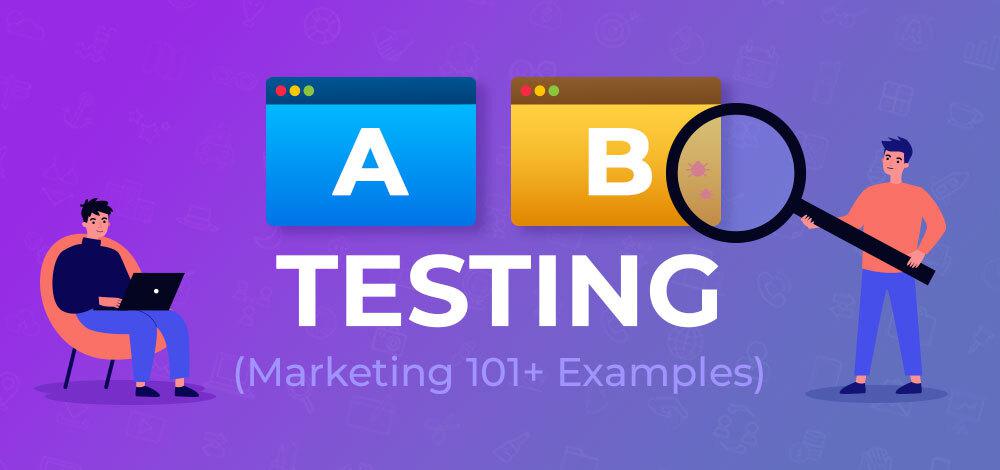A/B testing is an experimental method in which two versions of anything are contrasted to see which is “better” or more effective.
This is often done in marketing when two different types of content—whether it be email copy, a display ad, a call-to-action (CTA) on a web page, or any other marketing asset—are being compared. This is usually done before launching any product in the market so that the company can get better results.
This also helps in comparing the performance of two or more variants of emails and then selecting the best among them based on the result given by the audience. So, now without waiting any time let’s move forward and take a look that what is A/B testing:

What Precisely Is A/B Testing?
A/B testing or split testing, in a nutshell, is a means to compare two iterations of an email, website, or other marketing asset and assess the performance differences between them.
To accomplish this, distribute one version to one group and the other to a separate group. The effectiveness of every version may then be seen. It’s best to approach it as a competition where two versions of your assets are pitted against one another to determine which will prevail.
Making judgments about email copy, web pages, or other campaign assets in the future might be influenced by knowing which marketing asset performs best.
How Is A/B Testing Conducted?
To conduct an A/B test, you must produce two variants of the same content, each with a single variable altered. Afterward, you’ll present these two versions to two groups of people with identical sizes and compare their performance over a certain amount of time long enough to draw precise judgments regarding your findings.
A/B testing enables marketers to compare the performance of two different versions of marketing content. The following is the examples of A/B test types. Imagine you run an online store that sells clothing, and your goal is to boost the lead generation on your product pages. You choose to do A/B testing on two variants of your product page.
You keep the initial product page layout in control group A, which places the image of the product, synopsis, pricing, and “Add to Cart” button above the fold. You make a minor adjustment in experimental group B by moving the product review area under the “Add to Cart” button.
In the A/B test, 50% of the people who visit your website are randomly assigned to Group A, and the remaining 50% are randomly assigned to Group B. You keep track of the number of visitors from each category that add the product to their cart and then check out.
You evaluate the data from the A/B test after a week of operation and discover that Group B had a 10% greater conversion rate than Group A. This indicates that the inclusion of the product review area had a favorable effect on website users’ purchasing decisions.
Based on these findings, you decide to add a product review area to every one of your product pages to boost sales and conversion rates. This is but one illustration of how A/B testing in marketing may be utilized to make data-driven decisions and enhance the efficacy of your marketing initiatives.
Effective A/B Test Examples
A/B testing has emerged as a crucial tool for SaaS, e-commerce solutions, and company websites since the turn of the millennium. Most people are unaware that they are taking part in a test because it is simple to sample and track the visitors to a website.
A test was conducted by Google in 2000 engineers to determine the ideal number of results to show on a search engine results page. Since then, the solution (10 results per page) has stayed largely constant.
In 2008, Barack Obama’s presidential campaign tested an early donor page and discovered a CTA language and image combo that generated 40% more clicks. Similar experiments reportedly led to 4 million more sign-ups and $75 million more in political donations.
2009 saw the creation of a link by a Microsoft employee that launched pages in a new tab. The 8.9% increase in overall clicks on the MSN site is an indication that user engagement has significantly increased. The test was repeated in the US in June with about 900,000 participants from the UK.
Reasons To Conduct A/B Tests
A/B testing enables people, groups, and businesses to modify their user experiences with care while gathering information on the results. This enables them to generate hypotheses and discover which aspects and experience optimizations have the most influence on user behavior. An A/B test is another way to refute their assertion that a particular experience is the best one for reaching a particular objective.
A/B testing can gradually improve a specific experience or objective like conversion rate optimization (CRO) rather than merely addressing a one-time query or resolving a dispute.
A B2B technology firm could wish to increase the quantity and quality of sales leads coming from campaign landing pages. The team would try A/B testing adjustments to the headline, subject line, form fields, call-to-action, and overall layout of the page to optimize for a lower bounce rate, more conversions and leads, and a higher click-through rate.
They can identify which modifications had an impact on visitor behavior and which ones did not by testing one change at a time. They can eventually aggregate the effects of several successful experiment-based adjustments to show how a new experience is measurably superior to the old one.
What Is The Process Of A/B Testing?
Several actions that you may see in a scientific study must be taken to conduct an A/B test. You’ll choose one variable to test, just as in any scientific experiment. Whatever you choose can be your variable: the placement of a navigation menu or the color of a banner advertisement.
A/B testing gives you the ability to fully realize the potential of your business and marketing strategy. The steps for carrying out an insightful A/B test are listed below. After selecting your variable, you should:
- Build on your hypothesis. (What do you expect the result should become?)
- Based on the chosen criteria, create a “control” group and a “challenger” group.
- Divide your sample groups at random into subgroups of the same size.
- Decide on the sample size (if applicable to your test).
- Specify what constitutes a statistically significant outcome.
- Make sure that each campaign is only having one test running at a time. (Doing many tests at once risks compromising results and invalidating your test.)
Advantages Of A/B Testing
These are a few advantages of A/B testing:
1. Enhanced Content
For instance, while testing marketing content, users must be shown a list of potential upgrades. The simple act of developing, considering, and analyzing these lists eliminates unproductive language and improves the usability of the final products for consumers.
2. Reduces Costs
Companies can save money by using A/B testing to find procedures that produce better results. One marketing effort will always be superior to the other; no two campaigns will ever yield comparable results.Businesses can use A/B testing to identify the option that provides greater returns, eliminate the procedure that provides lower returns, and invest money where it pays off more.
3. Low Risks
You can lower risks by using A/B tests. You can run an A/B test to observe how a new update or component on your product affects your system and how users respond to it if you’re unsure of how it will perform. You may instantly roll back the code if it has a significant negative effect by utilizing a feature flag to run your A/B test.
4. More Engagement
The fact that 69 percent of businesses do A/B tests on emails is not surprising given that firms seek highly engaged customers and followers. Businesses can use it to determine the types of content that are most effective so they can focus more on those types.
Conclusion
A/B testing, to put it simply, compares two options to determine which one produces better results. One of the most effective techniques to bolster sales and marketing initiatives is unquestionably A/B testing. It advises you on the strategies that generate the greatest number of sales and demonstrates the messaging that attracts your most valuable clients.
While discussing A/B testing, several technical and scientific jargon is used, which can make the process seem scary.
Yet, that doesn’t take away from the fact that it’s a beneficial tool for boosting the lead generation of your marketing initiatives. Using this method consistently and regularly will have a significant positive effect on your company’s overall profitability.
FAQs
1. How does A/B testing work in marketing?
A/B testing or split testing is a kind of marketing experience where numerous tests are done on the audience by splitting them into groups. This is used for testing which variation of the product is best so that the better products are launched in the market.
2. What are the most famous A/B testing tools?
There are numerous A/B testing tools present in the market but the best ones are as follows:
- Google optimize
- VWO
- Hubspot A/B testing kit
- Crazy Egg
- Omniconvert
- Freshmarketer
- AB tasty
3. What are the different types of A/B testing?
These are the different types of A/B testing:
- Split testing
- Multi-Page testing
- Multivariate Testing




